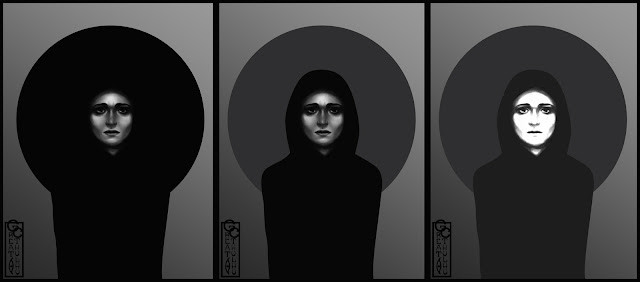My Favorite Artist at the Moment Justin Bower
Justin Bower paints his subjects as de-stabilized, fractured post-humans in a nexus of interlocking spatial systems. His paintings problematize how we define ourselves in this digital and virtual age while suggesting the impossibility of grasping such a slippery notion.
The ongoing decoding of the human body, a formula to each individual’s genome, confronts us with a radical question of “What are we? Am I a code that can be reduced and multiplied infinitely?” Bower’s paintings begin to open a dialogue to this destabilizing effect/trauma technology has on the individual that has infected the daily lives of contemporary man. He shows this destabilization through the doubling of features - multiple eyes, spliced noses, melting mouths - and the whiplash motion invoked in his Abstract Expressionist process.
Much like Francis Bacon and Da Vinci of generations past, Bower uses paint as an instrument of dissection and inquiry. Flesh acts as a complex veneer, functioning as a biological boundary from externalized technologies; all the while the viewer realizes that the same externalized technologies are always already inside the subject. This ultimately creates an open system, an incomplete subject becoming and degrading, not knowing where the outside starts and the internal ends. The boundaries of the traditional subject are now leaking in Bower’s concept.
His paintings reflect the increasing “control society” that we find ourselves in. By placing his turbulent subjects in an Op Art context, the familiar repeating patterns that were used to engage the eye in the 60’s, are now being deployed to act as a type of “code” permeating and invading the body/subject. Bower wants to “have the viewer feel the instability his subjects reflect”, by playing on the non-fixed features of the face and the hallucinatory effects of the Op Art, so as to engage the viewer and perhaps awaken them from a techno-slumber.
In the end, Bower’s subjects are an inquiry into the nature of autonomy in the modern subject. Is “free will” minimized in a society that deploys technology in an effort for more and more control over the individual? Have we ever really had it to begin with? Bower paints his subjects as an ontological problem, and as such, he sees…”the study of subjectivity functions best under the threat of vanishing”.
Born in San Francisco in 1975, Bower earned a degree in Art and Philosophy from the University of Arizona in 1998 and a Master of Fine Arts from Claremont Graduate University in 2010.
Since graduating from CGU, Bower’s work has been the subject of solo exhibitions at Ace Gallery Beverly Hills (2010) and Unix Gallery in New York City (2013).
Bower's work has been shown at galleries, museums, and international art fairs including: Stage Singapore (2015); Art Silicon Valley/San Francisco (2014); Start Art Fair at Saatchi Gallery in London (2014); Silicon Valley Contemporary (2014); The Palm Springs Fine Art Fair (2014 & 2015); Zona Maco Mexico (2014); The LA Art Show (2014 & 2015); Art Miami (2013 & 2014); Torrance Art Museum, Los Angeles (2013 and 2010); Los Angeles Contemporary Art Fair (2011 and 2013); Los Angeles Art Platform (2011); Art Aspen (2013 & 2014); and Art Southampton (2013 & 2014).
The artist has won and been nominated for several grants and awards, among them The Feitelson Fellowship Grant (2010) and The Joan Mitchell award (2010).
Bower's artwork has been published in Blisss Magazine (February 2014 cover), Modern Painters (February 2014: Reviews in Brief and September 2013: 100 Best Fall Shows), Studio Visit Magazine (2013 cover), Artillery Magazine (2010), the LA Times (2010), and New American Paintings (2010 cover).
Justin Bower -
"I paint the face as an uncanny representation and site of turbulent subjectivity. I use the face as a performative space, or armature, to interrogate the ‘humanist subject’ from a posthuman vantage point.
In this series of paintings I use an anonymous image culled from the internet, re-interpreting the image in every painting. The multiplicity and endless variation of this image confuses an authentic origin, reaffirming the tension between the digital image and a real world counterpoint.
I postulate and show that literally and figuratively, body boundaries are leaking and putting into question the stability of subjectivity. Biotechnologies, with its regenerative qualities and coding of the human, are suggested in my paintings as the endless generative quality of one image without an original. My subjects are contradictory and unstable, in an un-fixed position (optically and conceptually), courting a felt tension between rupture and rigidity in the construction of the painting. I use the doubling of certain features on the face (such as three eyes, spliced noses, melting mouths) to optically play with this instability, and I conceptually destabilize the subject by creating an open system that doesn’t complete the subject, addresses androgyny and the state of becoming/unbecoming.
I complicate the function of skin/flesh as a boundary between biological interiority and externalized technologies through the sense of ‘space’ or openings in the flesh. My posthuman ‘subjects’ play with the boundaries separating the organic/machinic, human/non-human, interiority/exteriority, and self/other binaries.
My paintings depict the subject not as identification but of transformation, metamorphosis and catastrophe. They are not representative, they are performative, a boundary site and surface---neither entirely natural nor cultural but a configuration that negotiates the limits of corporeal existence within an increasingly technological environment."






















Comments
Post a Comment